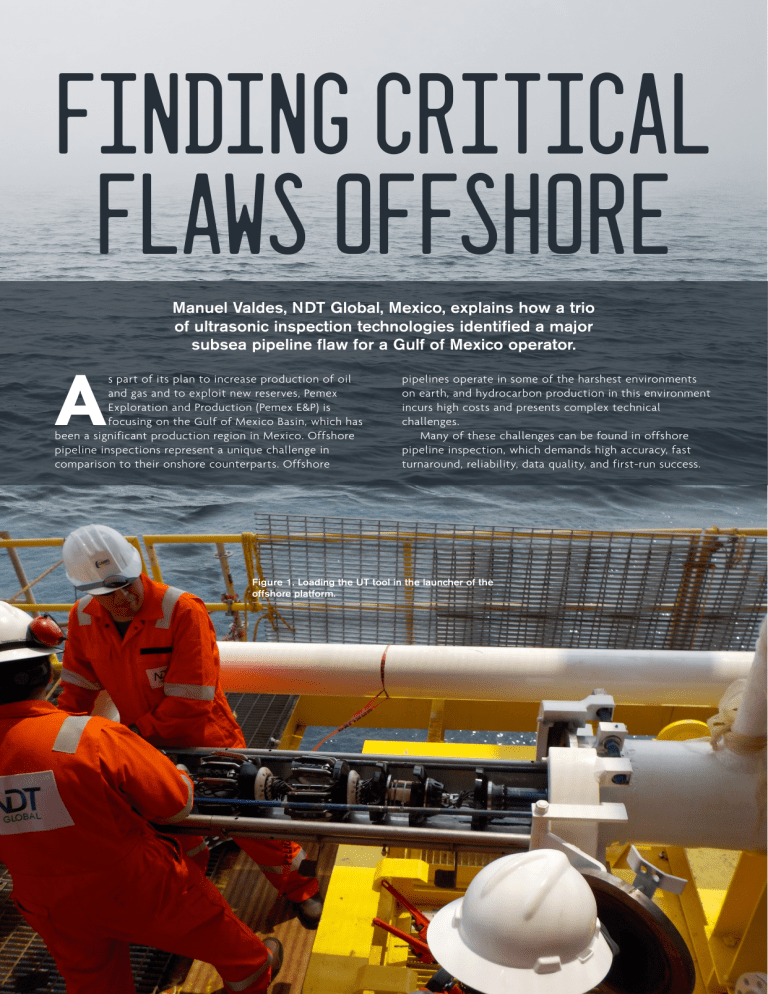
Finding critical flaws offshore A Manuel Valdes, NDT Global, Mexico, explains how a trio of ultrasonic inspection technologies identified a major subsea pipeline flaw for a Gulf of Mexico operator. s part of its plan to increase production of oil and gas and to exploit new reserves, Pemex Exploration and Production (Pemex E&P) is focusing on the Gulf of Mexico Basin, which has been a significant production region in Mexico. Offshore pipeline inspections represent a unique challenge in comparison to their onshore counterparts. Offshore pipelines operate in some of the harshest environments on earth, and hydrocarbon production in this environment incurs high costs and presents complex technical challenges. Many of these challenges can be found in offshore pipeline inspection, which demands high accuracy, fast turnaround, reliability, data quality, and first-run success. Figure 1. Loading the UT tool in the launcher of the offshore platform. Inline inspection providers must be able to meet all of these demands, so operators are able to make fully informed decisions on future interventions. With highly accurate and fast results, inspection intervals can be extended, required repairs can be performed more efficiently, and the requirement for costly verifications can be reduced. Potential economic value The six new fields targeted by Pemex have the potential to increase domestic crude oil production to 210 000 bpd by the end of 2020. This may return the operator’s production level to 2 million bpd, starting in the year 2021. This is significant, as Mexico’s crude oil production had decreased to 1.8 million bpd in 2018. Part of the operator’s strategy for the development of these Gulf of Mexico reserves is construction of new platforms and pipelines that will produce, gather, and transport the product. Many of these pipelines will transport high-temperature (over 50˚C), multi-phase (water-oil-gas) product, or will be connected to high-flow wells. It is not possible to restrict or limit production from these high-flow wells without incurring the potentially large economic costs of lost production. For these pipelines in particular, the pre-commissioning stage – immediately after pipeline construction is completed, and before the line begins flowing production – is the ideal point for diagnosis and integrity assurance. The pipeline for inspection Figure 2. Top: how the defect appears on wall thickness. Bottom: how the defect appears on geometric data. The pipeline requiring inspection was the Manik A Production Platform to Ixtal B Production Platform section. This line has an 8 in. nominal diameter and is 7.3 km in length. The wall thickness is 9.52 mm (predominant) and 14.28 mm in the riser and above-water, deck facilities section, with a steel grade of X-52. Potential threats included manufacturing defects (e.g. laminations, inclusions, seam-weld lack of fusion), gouges, and dents. After evaluating available methods to assess the condition of the pipelines, the operator selected NDT Global’s trio of ultrasonic solutions for these baseline inspections. Accuracy was essential, because these inspections established the foundation of an enhanced pipeline integrity programme. Specific inspection technologies The EVO Series 1.0 UMp compression-wave robot is used for metal loss inspection; mill anomalies such as laminations and inclusions; and quantitative wall-thickness measurement, with high resolution for pitting detection and sizing. Inline inspection with this robot is designed Figure 3. Physical appearance of the anomaly. to cause no loss or reduction of throughput, which eliminates a potentially high cost associated with other methods. Inspection speed is also up to four times faster than other methods, and axial resolution is up to four times greater. The EVO Series 1.0 UC shear-wave robot is engineered specifically for high-precision inspection of axial cracks in the pipe body and long seam Figure 4. Wall thickness and geometric software image overlaps actual defect image. The welds, including stress corrosion inspection data is highly correlated with the damage. cracking and lack of fusion. The World Pipelines / REPRINTED FROM FEBRUARY 2020 robot provides absolute crack sizing for the full range of crack depths, and does not reduce flowrate. The EVO Atlas UG+INS is a geometry-specific robot that can be combined with the other robots for combined inspections, to increase inspection efficiency. Multiple data sets can be gathered in a single inspection, without time-consuming calibration. Combined inspections enhance identification of combined defects, as the data is fully aligned. Data analysis uses this amalgamated data with improved identification of corrosion associated with dents. The detection, identification, and sizing capabilities of Atlas UG include dents, ovalities, buckles, wrinkles, off-takes, roof topping and out-of-roundness, and pipe expansion. Additional challenges The operator wanted to fast-track the preparation stage of the project. This stage included technical data gathering and reviewal, ILI robot drawing request and release, parts disposal, assembly, and mobilisation. Other challenges included performing ILI robot refurbishment and modification onboard the work ship. Upon retrieving the robot from the receiving platform, the robot operator disassembled the ultrasonic modules to replace the spare parts, changed the sensor carrier from UMp to UG, and added the INS module. Because all work was performed on the work ship, and the necessary resources had to be onboard as well, less time was required for reconfiguration and preparation. The ability to reconfigure the robot was critical to meeting this tight schedule. NDT Global was able to perform the inspection using two robots, in three runs. Since all three robots could not be provided on such short notice, the UMp robot was modified to UG+INS specifications for that inspection. Figure 5. UMp sensor carrier during the loading procedure. Additionally, data management was included for an agile run validation and analysis. This function required assuring data transmission, resources to expedite data review and preparation, and adjusting the process for immediate reporting of critical findings. Furthermore, accurate data set correlation was essential, because multiple inspection solutions were providing data. The use of high-resolution ultrasonic geometry is designed to ensure complete coverage of the pipe wall. This coverage is maintained in bends with no loss of data. The absence of mechanical calipers ensures that there is no risk of damage to the robot, and allows the flexibility to perform bidirectional inspections. Major anomaly detected A critical reason why the operator chose NDT Global was because of a very tight schedule, with short notice to mobilise and the confidence that this company could provide results. In the pre-commissioning inspection, NDT Global detected a major anomaly during the run validation. This was an interesting feature that combined both metal loss and a dent, which indicated gouge-type damage. In order to conform to the operator’s schedule, the scope of work specified a run validation in less than 24 hours, which included reviewing the run data and grading the information quality. NDT Global then immediately reported the findings so that the operator was informed in advance and could plan all necessary actions. The feature was detected under the seabed at 70 m depth. After the critical anomaly was first reported, the pipeline failed to pass the hydrotest. As a result of the quick, initial analysis and report – less than 24 hours after the retrieval of the robot – the operator was made aware as to why there was a loss of pressure. The most effective robots are only as good as the analysis of the data they produce. This was a factor in the operator’s choice of inspection technologies. NDT Global data analysis personnel are trained according to the latest version of ANSI/ASNT ILI-PQ-2010 In-Line Inspection Personnel Qualification and Certification Standard. The analysis team had 580 years of combined data analysis experience. An ultrasonic baseline inspection for offshore pipelines provides operators with the ability to better understand the current condition of a pipeline, to help simplify root-cause analysis later in the lifecycle, and to be able to costeffectively assess any leaks generated during the construction process. For example, the daily costs of a construction vessel trying to locate a leak are approximately US$110 000, with diving costs as an additional expense. The operator was also able to start flowing product through the line, and earning revenue, much sooner. REPRINTED FROM FEBRUARY 2020 / World Pipelines


